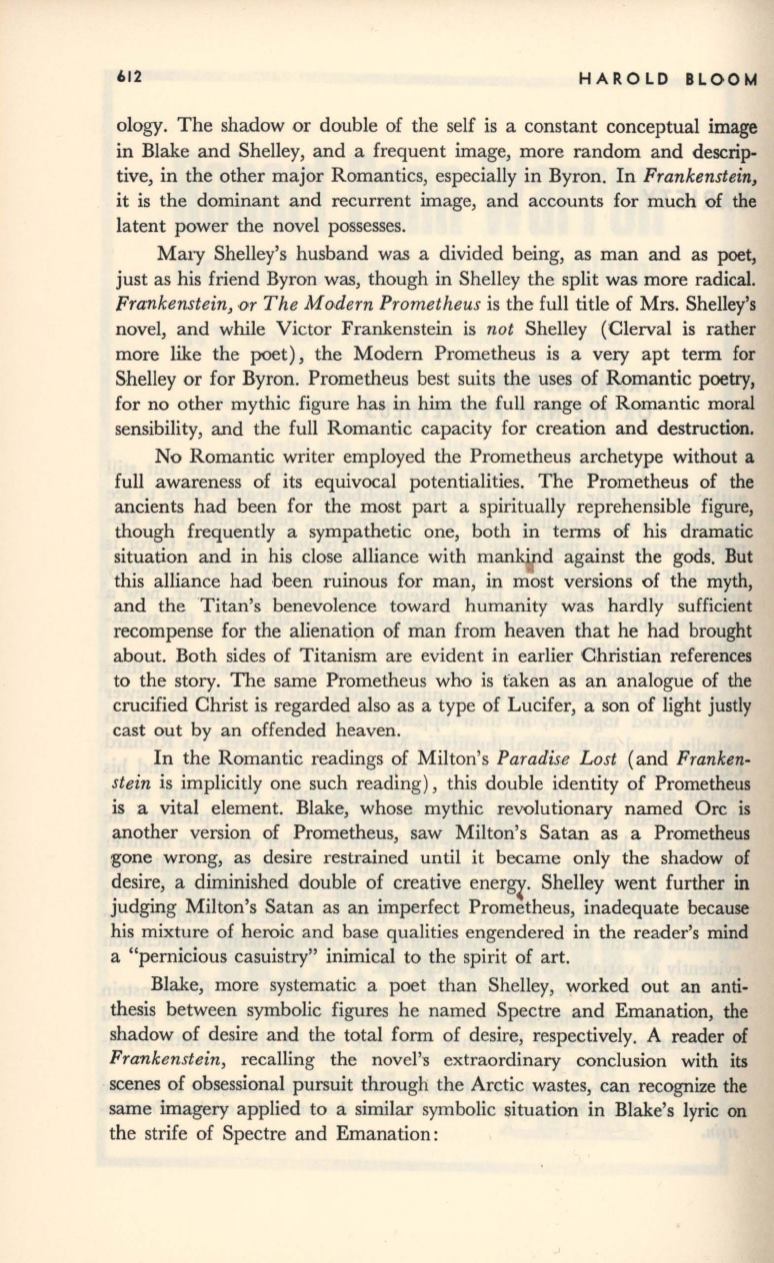
612
HAROLD BLOOM
ology. The shadow or double of the self is a constant conceptual image
in Blake and Shelley, and a frequent image, more random and descrip–
tive, in the other major Romantics, especially in Byron. In
Frankenstein,
it is the dominant and recurrent image, and accounts for much of the
latent power the novel possesses.
Mary Shelley's husband was a divided being, as man and as poet,
just as his friend Byron was, though in Shelley the split was more radical.
Frankenstein,
.or
The Modern Prometheus
is the full title of Mrs. Shelley's
novel, and while Victor Frankenstein is
not
Shelley (Clerval is rather
more like the poet), the Modem Prometheus is a very apt term for
Shelley or for Byron. Prometheus best suits the uses of Romantic poetry,
for no other mythic figure has in him the full range of Romantic moral
sensibility, and the full Romantic capacity for creation and destruction.
No Romantic writer employed the Prometheus archetype without a
full awareness of its equivocal potentialities. The Prometheus of the
ancients had been for the most part a spiritually reprehensible figure,
though frequently a sympathetic one, both in terms of his dramatic
situation and in his close alliance with mank· d against the gods. But
this alliance had been ruinous for man, in most versions of the myth,
and the Titan's benevolence toward humanity was hardly sufficient
recompense for the alienation of man from heaven that he had brought
about. Both sides of Titanism are evident in earlier Christian references
to the story. The same Prometheus who is faken as an analogue of the
crucified Christ is regarded also as a type of Lucifer, a son of light justly
cast out by an offended heaven.
In the Romantic readings of Milton's
Paradise Lost
(and
Franken–
stein
is implicitly one such reading), this double identity of Prometheus
is a vital element. Blake, whose mythic revolutionary named Ore
is
another version of Prometheus, saw Milton's Satan as a Prometheus
gone wrong, as desire restrained until it became only the shadow of
desire, a diminished double of creative
ener~.
Shelley went further
in
judging Milton's Satan as an imperfect Prometheus, inadequate because
his mixture of heroic and base qualities engendered in the reader's mind
a "pernicious casuistry" inimical to the spirit of art.
Blake, more systematic a poet than Shelley, worked out an anti–
thesis between symbolic figures he named Spectre and Emanation, the
shadow of desire and the total form of desire, respectively. A reader of
Frankenstein,
recalling the novel''S extraordinary conclusion with its
scenes of obsessional pursuit through the Arctic wastes, can recognize the
same imagery applied to a similar symbolic situation in Blake's lyric on
the strife of Spectre and Emanation:


